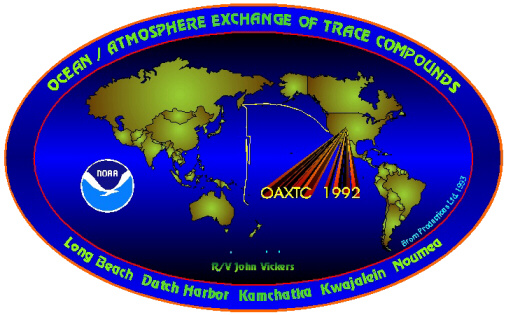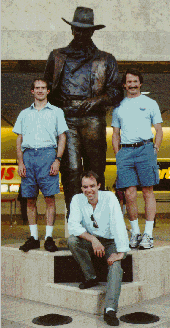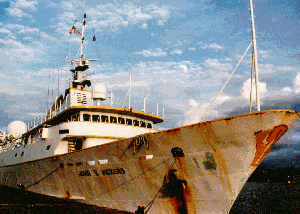O A X T C 9 2 - Ocean / Air Exchange of Trace Compounds (1992)

Abstract
The main goal of this study was to determine the atmospheric mixing ratio of hydrochlorofluorocarbon 22 (HCFC-22) and its partial pressure in surface waters of the West Pacific Ocean to assess the possible existence of an oceanic sink for this compound. The ship started out of Long Beach, CA, and reached Dutch Harbor, AK, one week later. The cruise continued to a point offshore of Kamchatka, Russia, Kwajalein Atoll, Marshall Islands, and finally ended in Noumea, New Caledonia, 12 weeks after it began.
CFC-11 (CCl3F), CFC-12 (CCl2F2), CFC-113 (CCl2FCClF2), methyl chloroform (CH3CCl3), carbon tetrachloride (CCl4), nitrous oxide (N2O) and HCFC-22 (CHClF2) were measured in the air and surface waters of the Pacific Ocean between 55°N and 22°S during the late summer and early fall of 1992. Atmospheric measurements of all gases agreed well with results from NOAA fixed stations at similar latitudes. CFC-11, CFC-12, and CFC-113, which have long atmospheric lifetimes and are essentially inert in seawater, responded mainly to physical processes in the air and water. The first two gases were supersaturated by 2-6% at higher, northern latitudes, reflecting the effects of radiative warming. Their saturation anomalies declined southward through the tropics and ultimately became slightly negative in the southern hemisphere. HCFC-22 showed signs of small losses in the tropics and subtropics, a sink that may account for 2% of the losses of this gas from the atmosphere. CH3CCl3 showed a similar pattern, with only a tropical sink. This is consistent with hydrolysis and, together with data from an earlier expedition, implies that about 6% of atmospheric CH3CCl3 is lost to the ocean. The net saturation anomaly for CCl3 was virtually negative everywhere and only slightly dependent upon latitude. This would be expected for a sink that was not particularly temperature dependent and it is consistent with evidence from deepwater profiles that indicate a sink at depth. Fluxes calculated from CCl4 saturation anomalies indicate that 15-35% of atmospheric CCl4 is lost to the ocean.
Methods and list of measured compounds:
| Gas chromatograph / electron capture detector (surface water): | |
| HCFC-22
(also at depth) |
CHClF2 |
| CFC-12 | CCl2F2 |
| CFC-11 | CCl3F |
| CFC-113 | CCl3CF3 |
| Methyl chloroform | CH3CCl3 |
| Carbon tetrachloride | CCl4 |
| Nitrous Oxide | N2O |
Cruise Participants:
- Jürgen M. Lobert (legs 0, 1, 2a, 2b)
- Thomas J. Baring (legs 0, 1, 2a, 2b)
- James H. Butler (legs 0, 2b)
- OAXTC 92: OCEAN / ATMOSPHERE EXCHANGE OF TRACE COMPOUNDS 1992 Oceanic Measurements of HCFC-22, CFC-11, CFC-12, CFC-113, CH3CCl3, CCl4, and N2O in the Marine air and Surface Waters of the West Pacific Ocean (03. August to 21 October 1992),
- J.M. Lobert, J.H. Butler, T.J. Baring, R.C. Myers, S.A. Montzka, J.W. Elkins, NOAA Technical Memorandum ERL CMDL-9, July 1995.

From left to right: Tom, John Wayne, Jürgen, and Jim (just arriving at John Wayne Airport in Long Beach, CA) .
The Platform:

The John V. Vickers is about 67 m long and fast. Formerly a tuna-fish boat, the Vickers was converted to a scientific vessel in the late 80s. It served several major missions (WOCE, TOGA/COARE) carrying a crew of about 14 with a capacity of 24 scientists, before it was retired in 1993.
Cruise Track:

OAXTC 92 is shown in dark green through the Pacific Ocean, out of Long Beach, California into Noumea, New Caledonia.
